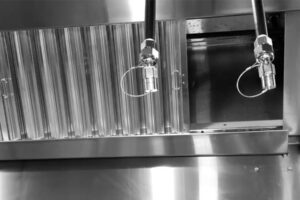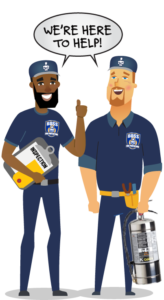One of the most important devices on your fire suppression system is the pull station. This is the manual means of operation for the employees or business owners to set off the fire suppression system in case of a fire.
The remote pull station is mounted on the path of egress towards the exit of a kitchen and shall not be obstructed and noticeable. In case of a fire you should try to use the portable K-Class extinguisher first, if that does not put out the fire you should then go to the manual pull station. The manual actuator will have a break rod and extended wire behind the pull device so you will need to make sure you pull the device hard enough to break the rod and extend the loose wire to actuate the system. When this process is complete the fire suppression system has been actuated and the wet chemical will go through the piping to the designated area covered by the fire suppression system under the hood.
A commercial restaurant fire suppression system is designed to automatically detect and suppress fires in a kitchen environment to protect both people and property. When the system is activated manually from a pull station, here are the typical steps of what happens:
-
Manual Activation:
- A person, usually an employee or the kitchen staff, observes a fire or smoke condition that requires the activation of the fire suppression system. They locate the manual pull station, which is typically located near the kitchen or in an easily accessible area.
-
Pulling the Manual Station:
- The individual physically pulls the handle or pushes the button on the manual pull station. This action sends a signal to the fire suppression control panel, indicating that a fire emergency has been manually initiated.
-
Alarm Notification:
- The fire suppression control panel receives the signal from the manual pull station and activates the building’s fire alarm system. This alerts building occupants to the fire emergency, allowing them to evacuate the premises safely.
-
Activation of Fire Suppression System:
- Upon receiving the signal, the fire suppression control panel initiates the discharge of the fire suppression system. This typically involves releasing a fire-extinguishing agent or a combination of fire-extinguishing agents, such as wet chemicals, foam, or clean agent gases (e.g., CO2 or FM-200). The specific type of agent used depends on the system’s design and the type of fire being suppressed.
-
Suppression of Fire:
- The fire-extinguishing agent is discharged through nozzles strategically placed in the kitchen area. It is designed to quickly suppress the fire by cooling, smothering, or interrupting the chemical reactions involved in the fire. The system is specifically tailored for kitchen fires, which often involve grease and cooking appliances.
-
Shutdown of Cooking Equipment:
- Some fire suppression systems are integrated with electrical or gas shutoff mechanisms. When the system is activated, it can automatically shut down cooking equipment to prevent further fuel supply to the fire.
-
Safety Measures:
- Occupants and staff should already be evacuating the area as soon as the fire alarm activates. The fire suppression system works to control the fire while people are safely outside the affected area.
-
Fire Department Notification:
- In many cases, the fire alarm system is also connected to a monitoring service that notifies the local fire department of the fire. This ensures a quick response from the fire department, even if no one is present to make the call.
-
Post-Activation Inspection and Reset:
- After the fire has been successfully suppressed, the restaurant staff, fire department, or a qualified technician will need to inspect and reset the fire suppression system. This includes refilling the system with the extinguishing agent, inspecting nozzles and components, and ensuring that the system is fully operational for future use.
It’s important to note that the specific sequence of actions and components of a fire suppression system can vary depending on the manufacturer and type of system installed. Restaurant fire suppression systems are designed to be effective and quick in responding to kitchen fires to minimize damage and protect lives.
Watch this short video for visual explanation of exactly what happens when your fire suppression system is engaged.
If you have any additional questions about your fire suppression system or need to talk to a certified technician, please feel free to give Boss Fire Protection a call at 972-704-1821.





